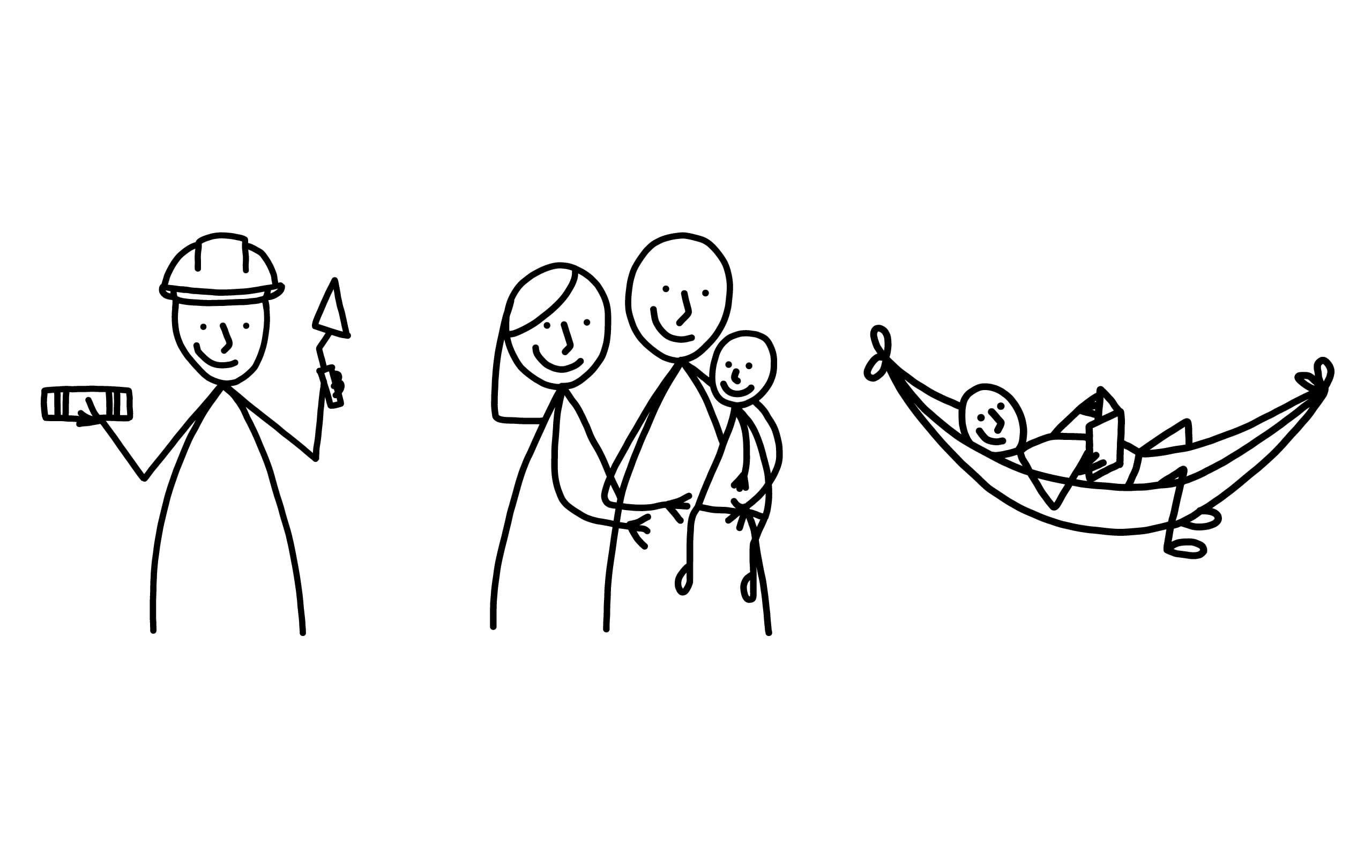
The question remains however of whether they want to become officially married at the registry office or simply continue on as life partners – they haven't yet decided. First, they want to find out more about the legal and financial consequences of marriage.
Points in favor of and against marriage and life partnerships
1st pillar: old-age and survivors' insurance (AHV)
If married: If Nina and Tom marry, each will receive spousal AHV benefits for the contributions made by the other. The total pension amount married couples may receive is limited to 1.5 times (150 percent) of CHF 2,450, the maximum pension amount which an individual may receive (as of January 1, 2023). This means that couples who have continuously contributed to the 1st pillar without any contribution gaps can jointly receive a maximum of CHF 3,675 per month (as of January 1, 2023).
If Tom were to die, Nina, as his wife, may be entitled to a lifelong widow's pension. This would apply if Nina were over the age of 45 and had either been married to Tom for at least five years or had children with him. If the situation were reversed, Tom would receive a widower's pension until the youngest child reaches the age of 18. Their children would receive orphan's pensions, were their parents to die.
Life partnership: Couples in a life partnership who are both gainfully employed enjoy an advantage over married couples when it comes to retirement pensions. If neither have accrued any contribution gaps, Nina and Tom can receive individual pensions (in each case 100 percent) of a maximum of CHF 2,450 per month, or CHF 4,900 in total: 25 percent more than a married couple, each. However, they have no entitlement to a survivors' pension if one of them dies. Their children and children from outside the marriage would still receive orphan's pensions.
2nd pillar: Occupational retirement provision (pension fund)
Upon retirement, Nina and Tom can choose between a lifelong annuity or a one-off capital withdrawal. The marital status only influences one thing here – if Tom and Nina are married, their income is taxed jointly. If they are living as life partners, separate tax calculations are made, which, financially speaking, is often more advantageous as a result of progressive taxation. The situation is different in the event of death.
If married: If either spouse dies, Nina or Tom would receive a survivor's pension from the other's occupational retirement provision. To qualify for such a pension, they must have been married for at least five years, Nina and/or Tom must be over the age of 45, or they must have parental child support obligations.
Life partnership: The federal law on occupational retirement provision does include benefits in the event of the death of a life partner. Some pension funds, however, such as the Vita Collective Foundation, offer "partner pensions". Couples who live in a marriage-like arrangement or have children together should definitely send a written registration notice to their pension fund. The partner pension can then be applied for in the event of death.
Vested benefits
Vested benefits are treated in a similar way to distribution from pillar 3a. Nina and Tom can access these five years before retirement age at the earliest, and five years after at the latest. As a rule, the vested benefits amount is paid out as a one-off lump sum.
As with occupational retirement provision, marital status only has tax implications for vested benefits.
If married: In the event of death, the bank or insurance company with custody of the vested benefits account of the deceased spouse distributes a capital payment to the surviving spouse. Orphans and ex-spouses may also receive benefits if entitled.
Life partnership: Nina and Tom would be able to name each other as beneficiary, enabling the capital payment from their vested benefits accounts to be paid out to the survivor in the event of death. They must, however, communicate their wishes in writing to their vested benefits institution, so that the institution can carry out these out should the occasion arise.
3rd pillar: Restricted (3a) and unrestricted (3b) pension plans
The 3rd pillar distinguishes between restricted (3a) and unrestricted (3b) pillars.
Nina and Tom can access the capital from pillar 3a five years before retirement age at the earliest, and five years after at the latest. Upon distribution at regular retirement age, the pension benefits from pillar 3a will be taxed at a reduced rate, separate from any other income of the married couple / the respective person.
Nina and Tom will receive the capital from pillar 3b upon expiry of the life insurance. Distribution from pillar 3b is tax free under certain conditions.
If married: In the event of death, the pension assets in pillar 3a will first be awarded to the surviving spouse. Nina or Tom, as the case may be, would receive all of the capital accumulated in a restricted pension plan.
Life partnership: If unmarried, Nina and Tom would not be entitled to withdraw the accumulated capital from a restricted pension plan. Under certain circumstances, however, the surviving life partner may have entitlements. For example, if he/she lived with the deceased during the five years prior to death or has support obligations for one or more children. In such a case, the life partner has the same rank in the order of beneficiaries as the children. Notification of such must, however, be submitted in writing to the insurance company. It is generally recommended that life partners name one another as a surviving beneficiary of a life insurance policy in an unrestricted pension plan. The order of beneficiaries for life insurance policies in pillar 3b can be freely determined.
Taxes
If married: If Tom and Nina are married, they file their tax returns jointly. Their incomes are added together. The more they earn, the higher the tax rate. As they both have earnings, they pay more federal tax than they would if they were life partners. The Swiss Federal Tax Administration estimates around 700,000 married couples are currently affected by this so-called "marriage penalty" for direct federal tax. Efforts to change this situation have been underway for quite some time.
Life partnership: Life partners file separate tax returns. They pay income and wealth tax individually. Unmarried couples have an advantage over married couples because tax rate progression has less of an impact on them, particularly in the case of direct federal tax.
Estate law
If married: Swiss law regulates who receives what, if someone dies and there is no testamentary disposition (will or testamentary contract). The spouse takes precedence. If Tom and Nina have children, the survivor of the two must share half the estate with the descendants, if any. If the deceased has no surviving children, the surviving spouse receives the entire sum.
Life partnership: If Tom and Nina are not married, the law does not provide for any inheritance. The statutory laws of descent and distribution apply in case of death, and these favor the descendants in terms of precedence. If there are no children and no testamentary contract or will, the deceased person's estate goes to the parents. It is thus recommended that life partners name each other as beneficiary to avoid the survivor being left with nothing in the event of death. According to the law, the children of the deceased inherit at least half, and the compulsory portion for parents is abolished. Those without children can make the surviving life partner their sole heir.
Life partnership contracts
Nina and Tom conclude that, if one of them were to die, the survivor would be more financially secure if they were married than if they are simply life partners. If they were to remain life partners, however, they would be better off with regard to pensions and income tax. However, depending on the canton, in the case of life partnership a gift tax is applicable during the lifetime of the couple, or inheritance tax in the event of death. But what are the ramifications regarding children if they are simply life partners? What if Nina or Tom works less or stops working altogether to take care of the children?
Nina and Tom's pension advisor suggests a life partnership contract as a solution. This contract regulates what support funding is to be provided from which bank accounts, and in what proportions household and housing costs and assets are to be shared. The pension adviser also recommends making a list of their assets and property items and implementing medical powers of attorney. Nina and Tom's pension fund offer partner pensions. The pension advisor gives the pair the necessary forms to submit an application for a partner pension to their pension fund (notification of life partnership and specification of death benefit beneficiary). With a partner's pension, Nina and Tom can name each other as beneficiary in the event that one of them should die. Their pension advisor also recommends implementing a will and living will as well as taking out life insurance. "It's not the most streamlined solution," the pension advisor agrees, giving an encouraging smile upon seeing the long faces of Nina and Tom. "Should you wish to marry, I would still also recommend you organize a will, life insurance and living will."
But for Nina and Tom the emotional aspects are more important than the pragmatic ones, they want to promise to love and be faithful to one another forever. The day before the wedding ceremony, Nina and Tom go to the civil registry office to be officially married in the presence of their parents and other witnesses. The weather is absolutely fantastic on the day of the big barbecue by the lake. The reception and party carry on into the small hours of the morning, and apart from the best man falling into the water, the evening turns out to be just as perfect as they envisioned.
What does their pension fund require after they get married?
While Nina and Tom are on their honeymoon in Canada, a number of administrative processes are going on behind the scenes. Nina and Tom's employers notify their pension funds that they are now married. The funds will then calculate the value of their accumulated retirement assets (vested benefits) to date. This is necessary so that, in case of divorce, the increase in their retirement assets during the period of marriage can be calculated separately for each spouse. In a divorce, the respective partners are generally entitled to half of the increase in retirement assets.
When Nina and Tom return from their honeymoon, their new pension certificates are waiting for them in their mailbox. The will has also been completed, they have filled out the living will and made provision for one another with a risk life insurance policy. Whatever may come: Tom and Nina can look forward to their future with peace of mind.
Note: Since July 1, 2022, same-sex couples may be legally married in Switzerland. Consequently, new registered partnerships are no longer possible. Existing registered partnerships can be converted into marriages. The legal differences primarily concern naturalization, adoption and reproductive medicine.


